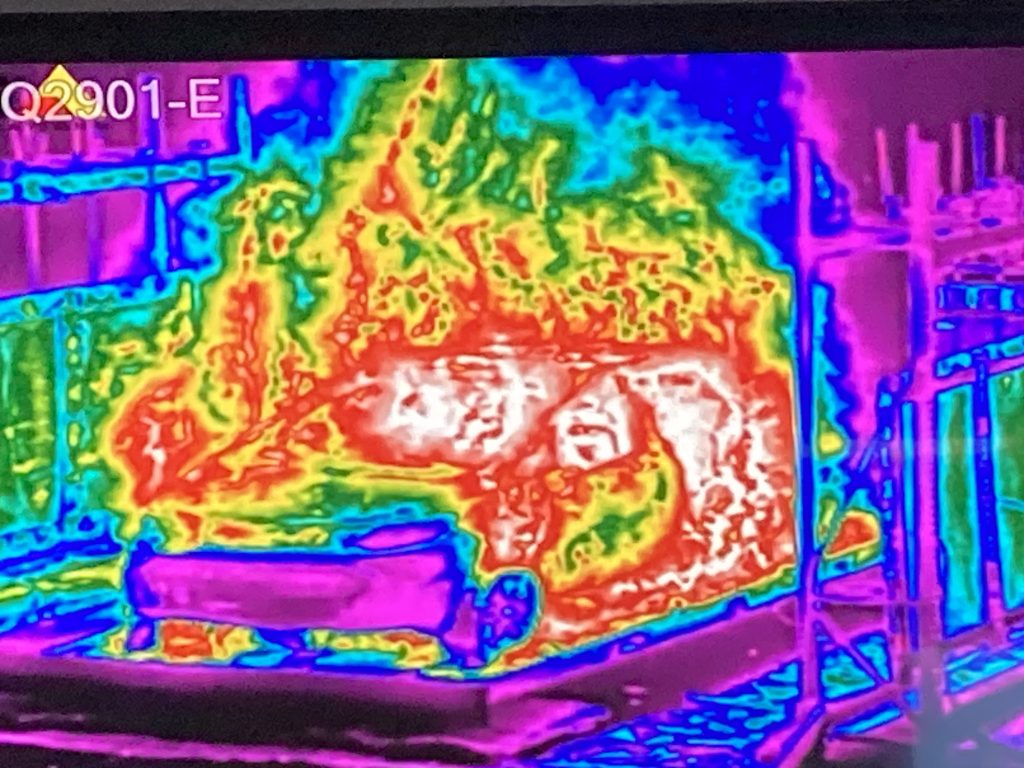Thermal Runaway and EV Fires: What Firefighters Should Know
As electric vehicles (EVs) are becoming more prevalent on our roads, they provide exciting opportunities for a greener future—but they also present unique challenges for firefighters. EVs do not behave like gasoline-powered vehicles when on fire. One of the most dangerous threats we face, now, is a process called thermal runaway—and understanding how thermal runaway works can save lives.
What is Thermal Runaway?
In layman’s terms, thermal runaway is when the temperature of a battery cell rises uncontrollably. It can happen from physical damage, overheating, or electrical failure. Once it starts, the chemical reactions occurring within the battery accelerate and produce more heat, leading to fire or explosion.
The scary part?
One failing battery cell can cause the adjacent cells to erupt in flames, creating a cascade effect. The entire battery packs can be ignited in a matter of seconds. And even when the flames are out, the danger is not necessarily gone.
How EV Fires are Different
EV fires add a new dimension of complexity to fire service emergency response. Here is why:
Re-ignition risk: Even after the fire has been extinguished, battery packs maintain latent heat, which can cause the battery to re-ignite hours or even days later.
Toxic gas release: Burning lithium-ion batteries release toxic gases, including hydrogen fluoride, carbon monoxide, and flammable vapors, and can pose serious health risks to first responders and civilians.
Higher fire intensity: EV fires may burn hotter and longer than traditional gasoline fires. They often require tens of thousands of gallons of water to suppress, sometimes needing to submerge the entire battery pack.
Unpredictable behavior: With a gasoline fire, the fuel source is known and predictable. Battery fires can be unpredictable. Parts of the battery may smolder for a long time, only to spontaneously ignite later on.
The Dangers for Firefighters
1. Re-ignition and Monitoring:
Having extinguished the visible flames does not mean the battery is safe. Firefighting crews must remain on scene long after the initial suppression, continuing to monitor battery temperatures using a thermal imaging camera. If things do not go as planned and the battery pool ignition goes unnoticed, the crews may leave quickly and be surprised by a re-ignition and chaos may ensue.
2. Toxic exposure:
Even when wearing full self-contained breathing apparatus (SCBA) protection, being exposed to the toxic gases generated from a burning electric vehicle can lead to toxic exposures that can either be acute or chronic. Toxic exposures can lead to serious injuries, and hydrogen fluoride is a corrosive gas that is dangerous even in small quantities.
3. Electrical Shock Hazards:
EVs utilize high voltages—typically ranging from 400 to 800 volts. Firefighters must recognize where they can cut safely, and what energized components, including wiring and battery packs, should be avoided. If a firefighter must extricate someone from a vehicle or conduct overhaul operations in an electric vehicle, insulated tools and gloves should be used with utmost caution.
4. Structural Collapse:
Fire from a battery may produce enough heat to compromise the structural components of the vehicle, especially if the battery pack is located under the floor. This would create a collapse hazard which could entrap or injure firefighters when conducting an interior attack or rescue.
5. Environmental Issues:
The same amount of water required to cool an EV battery packs will create another issue: contaminated runoff. The water used to cool the battery often includes heavy metals or toxic chemicals, which may create environmental concerns for either a stormwater system or local ecology.
Preparing for the New Reality
Fire departments must to comfort with the new vehicle landscape. This includes time, money, or other resources to get specialized training that include EV-specific tactics, changing standard operating procedures, and providing the thermal imaging and insulated tools for possible incidents.
This also includes collaborating with the manufacturers themselves. As EVs continue to appear on the road, it will be necessary to collaborate with manufacturers to provide better and quicker emergency response guides that include the location of high voltage systems and cutting methods for cutting the systems off safely.
On the technology side, it is possible that when vehicle batteries evolve and improve in their design parameters—batteries that are increasingly less susceptible to thermal runaway because of mitigative systems for thermal management, or because they are safer chemistries—it may limit some of the hazard. However, until that time, firefighters must remain vigilant and active.
Conclusion
Electric vehicles are not only the future, they are now.
As electric vehicle adoption continues to grow, departments will need to adapt their strategy to ensure they are protecting firefighters, and the community they serve. By recognizing that training and technology are available, and bringing together the community of manufacturers, we can address the issues of EV fires, while continuing to engage in the mission of saving lives, regardless of what is under the hood.
As electric vehicles (EVs) become increasingly prevalent, the firefighting community faces new challenges in dealing with vehicle fires, particularly those involving lithium-ion batteries. One of the most dangerous and complex phenomena associated with EV fires is thermal runaway. For those asking, “what is thermal runaway as it relates to EVs,” it refers to a rapid, uncontrollable increase in battery cell temperature that can lead to fire or explosion. This condition not only makes extinguishing fires more difficult but also introduces significant hazards for first responders.
Understanding Thermal Runaway
Thermal runaway occurs when the internal temperature of a battery cell increases rapidly due to mechanical damage, electrical failure, or exposure to heat. This leads to an uncontrollable, self-sustaining chemical reaction that produces intense heat and potentially explosive gases. In EVs, a single cell failure can trigger a chain reaction, causing adjacent cells to ignite in sequence—resulting in prolonged, violent fire events.
Fire Behavior in Electric Vehicles
Unlike traditional internal combustion engine (ICE) vehicles, EV fires behave unpredictably. Lithium-ion battery fires can re-ignite hours or even days after the initial event, especially if the battery remains damaged or improperly cooled. These fires emit toxic gases such as hydrogen fluoride, carbon monoxide, and flammable vapors that pose immediate health risks to firefighters and nearby civilians. Additionally, the fire intensity and duration often exceed those of gasoline fires, necessitating specialized suppression strategies.
Hazards to Firefighters
- Re-ignition Risk: After the visible flames are extinguished, latent heat within the battery pack can lead to re-ignition. Firefighters must maintain long-term observation or use thermal imaging to monitor temperatures post-extinguishment.
- Toxic Exposure: The combustion of lithium-ion batteries releases a mix of hazardous chemicals, including hydrogen fluoride, which can cause serious respiratory and skin damage. Standard self-contained breathing apparatus (SCBA) is essential, but extended exposure or accidental inhalation can still pose long-term health risks.
- Electrical Shock: EVs operate at high voltages—up to 800 volts in some models. Damaged battery systems or exposed wiring present a significant risk of electrical shock. Firefighters must be trained in identifying safe cut zones and must use insulated tools and gloves.
- Structural Integrity: Thermal runaway can compromise the structural integrity of EVs, including battery packs housed beneath the floor. Collapse or explosion from rapid energy release poses a blunt trauma hazard, especially in confined environments like garages or tunnels.
- Water Usage and Runoff: Large volumes of water are often required to cool and extinguish EV battery fires, but this generates runoff that may contain toxic contaminants. Environmental hazards and secondary cleanup are critical concerns, particularly in urban settings.
Conclusion
Firefighting strategies must evolve to address the unique challenges posed by electric vehicle fires and thermal runaway. Departments should invest in specialized training, updated protocols, and proper protective equipment. Collaboration with manufacturers for clearer emergency response guidelines and the development of safer battery technologies will also be crucial. As EV adoption grows, so too must the preparedness of first responders to safely and effectively mitigate these emerging hazards.




